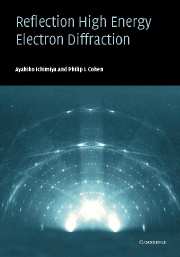Book contents
- Frontmatter
- Contents
- Preface
- 1 Introduction
- 2 Historical survey
- 3 Instrumentation
- 4 Wave properties of electrons
- 5 The diffraction conditions
- 6 Geometrical features of the pattern
- 7 Kikuchi and resonance patterns
- 8 Real diffraction patterns
- 9 Electron scattering by atoms
- 10 Kinematic electron diffraction
- 11 Fourier components of the crystal potential
- 12 Dynamical theory – transfer matrix method
- 13 Dynamical theory – embedded R-matrix method
- 14 Dynamical theory – integral method
- 15 Structural analysis of crystal surfaces
- 16 Inelastic scattering in a crystal
- 17 Weakly disordered surfaces
- 18 Strongly disordered surfaces
- 19 RHEED intensity oscillations
- Appendix A: Fourier representations
- Appendix B: Green's functions
- Appendix C: Kirchhoff's diffraction theory
- Appendix D: A simple eigenvalue problem
- Appendix E: Waller and Hartree equation
- Appendix F: Optimization of dynamical calculation
- Appendix G: Scattering factor
- References
- Index
2 - Historical survey
Published online by Cambridge University Press: 06 July 2010
- Frontmatter
- Contents
- Preface
- 1 Introduction
- 2 Historical survey
- 3 Instrumentation
- 4 Wave properties of electrons
- 5 The diffraction conditions
- 6 Geometrical features of the pattern
- 7 Kikuchi and resonance patterns
- 8 Real diffraction patterns
- 9 Electron scattering by atoms
- 10 Kinematic electron diffraction
- 11 Fourier components of the crystal potential
- 12 Dynamical theory – transfer matrix method
- 13 Dynamical theory – embedded R-matrix method
- 14 Dynamical theory – integral method
- 15 Structural analysis of crystal surfaces
- 16 Inelastic scattering in a crystal
- 17 Weakly disordered surfaces
- 18 Strongly disordered surfaces
- 19 RHEED intensity oscillations
- Appendix A: Fourier representations
- Appendix B: Green's functions
- Appendix C: Kirchhoff's diffraction theory
- Appendix D: A simple eigenvalue problem
- Appendix E: Waller and Hartree equation
- Appendix F: Optimization of dynamical calculation
- Appendix G: Scattering factor
- References
- Index
Summary
Early experiments
The first RHEED experiment was conducted by Nishikawa and Kikuchi in 1928. Their interest at that time was whether the Kikuchi patterns that had been observed previously in transmission electron diffraction (Kikuchi, 1928a, b) were also observed in reflection. Later they were interested in effects due to the refraction of electrons by a mean inner potential (Kikuchi and Nakagawa, 1934).
At the outset, efforts were made to understand the angles at which the diffracted beams showed intensity maxima. For reflection diffraction, the angular positions of the diffraction maxima do not follow Bragg's law. These shifts were explained to some extent by considering the beam to be refracted by an inner potential (Thomson, 1928).
Owing to refraction, the lowest-order diffracted beams are totally internally reflected and so are not observed. Using this effect, efforts were made to determine the mean inner potentials, the values of which are related to paramagnetic susceptibilities (see Chapter 9). In order to determine the mean inner potentials, the RHEED intensity was measured as a function of incident angle, a measurement that has become known as a rocking curve. From the systematic deviation of the positions of diffraction maxima from Bragg's law, the values of the inner potentials for several materials were determined for the first time by Yamaguti (1930, 1931). The refraction effects of the inner potential are also observed in RHEED patterns as parabolic Kikuchi lines and envelopes (Shinohara, 1935).
Information
- Type
- Chapter
- Information
- Reflection High-Energy Electron Diffraction , pp. 3 - 11Publisher: Cambridge University PressPrint publication year: 2004
